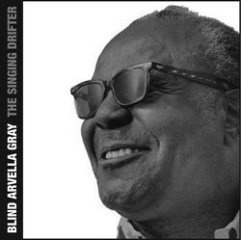Blind Arvella Gray - The Singing Drifter (2005)
Blind Arvella Gray - The Singing Drifter (2005)

01. There's More Pretty Girls Than One 02. John Henry 03. Arvella's Work Song 04. Take Your Burdens to the Lord 05. When the Saints Go Marching In 06. Standing By the Bedside of a Neighbor 07. Those Old Fashioned Alley Blues 08. Gander Dancing Song 09. Stand By Me 10. What Will Your Record Be 11. If I Could Hear My Mother Pray Again 12. Motherless Children Have a Hard Time 13. Take My Hand Precious Lord 14. Cryin' Holy Unto the Lord 15. Untitled Track Blind Arvella Gray - vocals, dobro
Blind Arvella Gray's real or imagined life story is, in some respects, a more complete creative statement than the actual music he made. Born Walter Dixon in Texas in 1906, he lost his eyesight and two fingers on his left hand due to a shotgun mishap (Gray's account of the incident involved several different plot possibilities), and he turned to street singing to keep things afloat. At some point in the 1940s he landed in Chicago, where he became a fixture at the Maxwell Street open-air flea market, playing his National Steel guitar and singing a mixed bag of blues, gospel, spirituals, work songs, and field hollers. By the early '70s he had released three 45s on his own Gray Records label, had four songs on a British import album called Blues from Maxwell Street, and had been featured in the video documentary And This Is Free. On September 22, 1972, he recorded his only album, The Singing Drifter, at Sound Unlimited Studios in Harvey, IL. The LP was issued on the tiny Birch Records label that same year, and quickly sold out its limited run in the Chicago area, where Gray's Maxwell Street presence had made him somewhat of a local celebrity. This reissue of The Singing Drifter on Conjuroo Recordings contains the complete original album, and adds four bonus tracks (plus an unlisted fifth bonus track, an alternate take of "Standing by the Bedside of a Neighbor"). Gray was hardly a skilled guitarist, as the missing fingers on his left hand limited him to slide playing, and he wasn't a particularly distinctive singer, either. What he had working for him was a certain joyful élan, which is why seeing him in person was undoubtedly more powerful than hearing him on record. The rhythms and vocal lines are very similar here track to track, which gives The Singing Drifter the illusion of being one long street song. The exceptions are a spirited rendition of what was Gray's unofficial theme piece, "John Henry," and a pair of field hollers, "Arvella's Work Song" and "Gander Dancing Song," where Gray sings accompanied only by his light handclapping. As an embodiment of the old street singer and songster tradition, Gray was undoubtedly a delight to see and hear at the market on a fine summer's morning, but a good deal of his presence is lost when all you have is his voice and guitar in the speakers. The Singing Drifter is certainly a valuable archival release, and those who saw him perform on Maxwell Street (Gray died in 1980) will treasure this disc for the memories it provokes, but it is truthfully a rather so-so musical document. In the end, it was Gray's physical presence as he stood playing that National Steel on the corner, and the long, storied journey (embellished or not) he took to get there, that was the real creative act. This album is the memento. ---Steve Leggett, Rovi
download: uploaded anonfiles mega 4shared mixturecloud yandex mediafire ziddu








